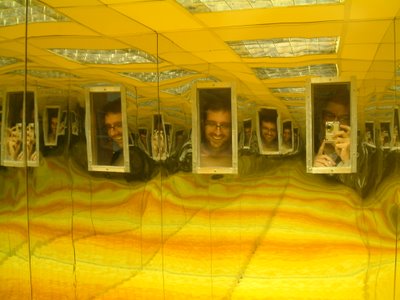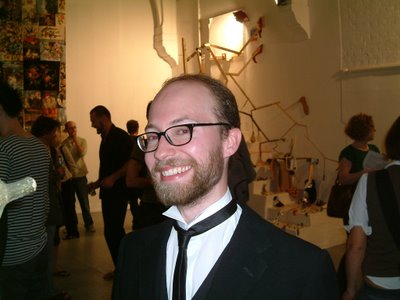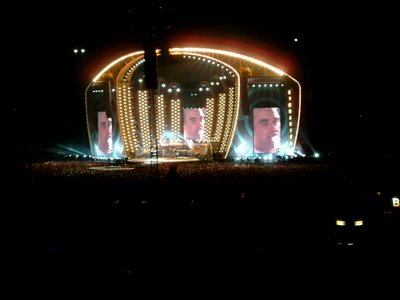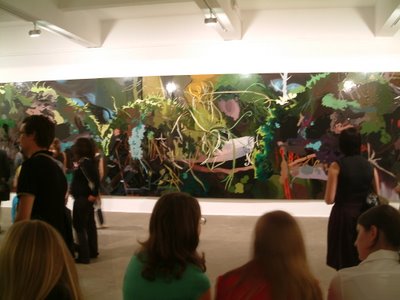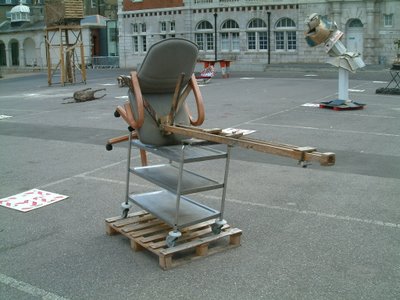Lunch at the Drive Thru
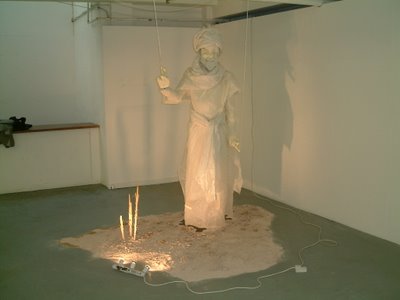
Now here's something I don't do very often. Hardly at all, in fact.
I go and see a show.
And I mean, I go and see it during one of the days that it's open - when it's quiet and there's no drink and there's no crowds and it's just a bunch of things in a room that look like art in an exhibition.
Weird, huh?
It's Three Colts and a show called Drive Thru that I couldn't make the opening of because of a prior engagement with Robbie Williams, but since I pretty much know everyone in the show, to lesser or greater degrees, I figure this is a show I can't possibly miss.
John Tiney is there when I arrive, invigilating for the day. I haven't seen him for a while and it's good to catch up.
We have a chat about stuff and then I get him to walk me thru the show.
There's piece called 'Bless You Fuck You' (above) by David Wilkinson which, slowly, I work out. A turbanned all-white figure seems to be floating slightly above the floor, with his hands by his sides. But look at this: the hands have strings attached to them that go up to the ceiling, then along and come down a few feet away. You can pull them and the figures hands rise. One hand has a symbol of peace (Bless You) and the other the finger (Fuck You). I play with this a bit. It makes me smile.
Then we are looking at John Summer's piece. It's a ...well, wait a second, what is it? Well, it's certainly a John Summers piece alright. OK, it's a sort of wooden frame that looks like a georgian window but which has been bent and curved out of shape and then covered with some gooey, sticky-looking half transparent stretchy material, through which you can see a thick jumble of kids toys - figures and cars, all mashed up. Eurghh. What a mess. It stands up off the floor, balanced at one end on just a bent piece of metal pipe.
Typically John, though. Tiney says that Summer's work has a 'complicated humour' which I think is an excellent description.
It also looks very wonky.
I say that there should be a group show called Winky Wonky.
'Minky Manky', says John straight back, which I kinda like because he gets the reference. I also then think in my head 'Winky Wanky' after what Tony Kaye did.
And if this isn't making sense, please don't adjust your set: for those of your watching in black and white: the brown is still behind the blue....
John then offers me some of his lunch - ham and cheese roll, very nice thanks, and we look around a bit more.
Lisa Penny has some work in a corner of the room. She sends me various bits and pieces as images attached to emails (as do a few people) and I like this a lot. It means you get to see a piece of work without any context or before and after - it's just some image out of nowhere. Anyway, here are three works of hers. A couple of images and a little coconut man buddha thing. I have absolutely no idea what it's all about. There's a large poster of what looks like a holidaying family, but the dad's face has been replaced by some weird maniacal horror face thing. Then there's a picture of a woman, with some of the photo shaded in with black felt tip.
Anything yet?
And then there's the little coconut man. He looks happy. Sort of.
Nope, haven't a clue. I must remember not to ask her about it when I next see her...
Moving on. 'This is by Tom Cox-Bisham,' says Tiney, pointing across - hang on, hang on, I say, we seem to have missed looking at this one...
It's Tiney's work. 'Ah yes,' he sighs. No one likes talking about their work and I sense he likes it less than most. (So I make sure I ask lots of questions.)
There's a quote from some press release ages ago about Tiney's work that has always stuck in my mind. It says something along the lines of 'John Tiney makes work in the spaces between culture(s)' (sic). I don't really know what this means, but whenever I see some of his work it seems to chime. Today is a case in point. There's a large 2D eagle in black and white, but with a few wings coloured in a rainbow palette, pulling a net with its claws in which are three cartoon birds in a big sock that look like they are off a cheesy Christmas card. Well, that's art in the space between cultures I think. The eagle looks like it's off the Eagle comic (the boy's own adventure comic from the 50's), but the wings have these colours on that could be from the peace flag, or from the gay pride flag, or even just from a rainbow. Who knows? Is there a definitive reading to all this? I suspect not. It's a good work. Though it looks cramped in the space here. The eagle looks so powerful it needs room to really fly.
OK, so now Tom's work. It's a big silver thing that looks to me like a pair of owl's eyes but turns out to be the symbol for a car. I don't get this piece at all.
So I look at it and poke my nose up close but it refuses to take me anywhere.
That's the way of it sometimes.
Then, finally, three works by Giorgio Sadotti. Now these are interesting. He mentioned to me before about these, saying he was putting some watercolours into the show. I struggled to picture Giorgio sitting out on a hill with a set of watercolour paints daubing away at a slice of paper on an easel, blue for the sky, green for the fields....
It's always hard to get away from that watercolour image.
But suffice to say Giorgio's watercolours are nothing like this. There are three and they are all called Face and then a number. Each one is a large piece of paper with three symbols painted on them, placed to suggest a face; two symbols for the eyes, one for the mouth. They are curious. Nothing like any of Giorgio's other work that I know. The symbols mostly seem to be logos or recognisable signs. They are placed high up in the paper and then the paper hung so that they seem head height, suggestive of an invisible body beneath them. They seem like lost souls though. As though the features have been reduced to logos and signs, as though that is all there is left...they feel quite sad to me. They seem quite lonely. Is this what is left of identity, living in an age where identity is a corporate construct? Or is it more hopeful than this? That an identity, with two eyes and a face, still looks out from behind all these surface constructs?
It's difficult to know. But I also think that's because this show presents a clutch of works that are themselves undecided about good and bad, hope and hopelessness, heaven and hell, bless you and fuck you. The answers to stuff are never black and white - or rainbow coloured, even. Picnics with the family are lovely - or hellish or both, at the same time, all the time. Nothing is ever simply one thing or another...
Blimey.
I finish my cheese and ham sandwich.
Well, there you go.
I drove thru.
drive thru pics


